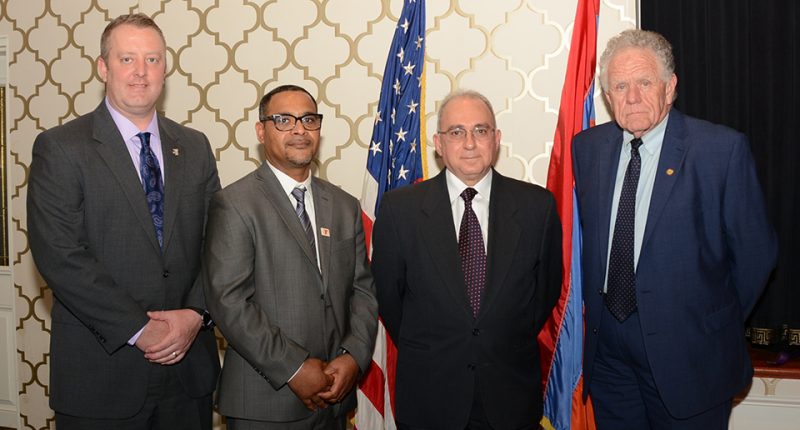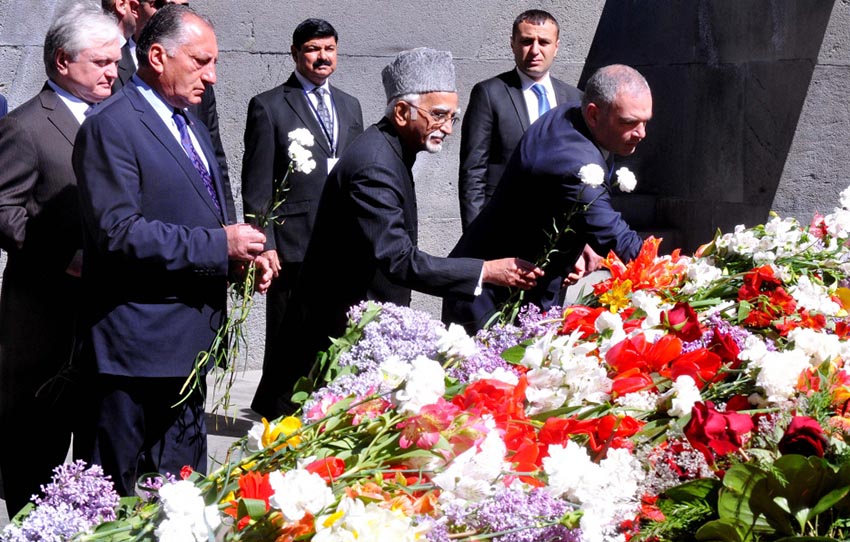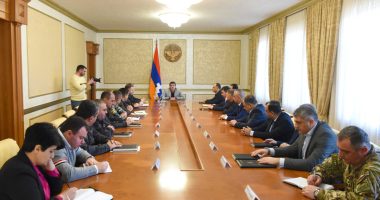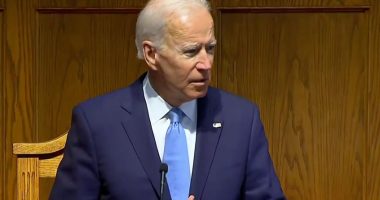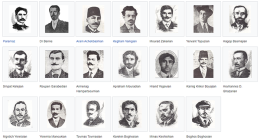PHILADELPHIA, PA – Armenian National Institute (ANI) Director Dr. Rouben Adalian was the featured guest speaker at the Armenian Inter-Communal Committee of Philadelphia’s Genocide Commemoration on April 24th where he presented on “The Decisive Role of the YMCA and American Relief in Armenia a Century Ago.” Based on John Elder’s photographs and testimony, as well as additional material from other archives, the exhibit pays tribute to the extraordinary efforts of two YMCA volunteers who went to Armenia during the first years of the newly-formed republic, John Elder and James O. Arroll, and whose philanthropic accomplishments were widely recognized at the time.
Executive Director of Greater Philadelphia YMCA Dave Mullin, Director of Information Technology of Greater Philadelphia YMCA Jean Scutt, and retired Director General of the Jerusalem International YMCA Leonard Wilson with his wife Joyce attended the presentation.
“Thank you for the great honor paid to the YMCA workers during the horrific events a century ago in your homeland,” retired Director General of the Jerusalem International YMCA Len Wilson stated. “I felt privileged to be in attendance during the very moving church service in your beautiful sanctuary, and to be in attendance for an excellent lecture by Dr. Adalian. I appreciated the opportunity to increase the awareness of your attendees to the role of John R. Mott and the Christian mission work he inspired via John Elder and James Arroll.”
Wilson added: “I was most impressed by the scholarly work accomplished by Dr. Adalian. I only wish more research was accomplished on the hundreds of World Service workers inspired by John R. Mott. Dr. Mott’s career and accomplishments need to be illuminated for persons outside the YMCA organization to appreciate the goals of our organization that is not a church or a religion, but acts to achieve cooperation and reconciliation embodying the true spirit of our Lord among persons of all faiths.”
John R. Mott, who is also featured in the exhibit, was the longtime General Secretary of the International Committee of the YMCA in the early 20th century and an early advocate for U.S. humanitarian relief for Armenians, who inspired Elder and Arroll to take on the challenge of going to Armenia.
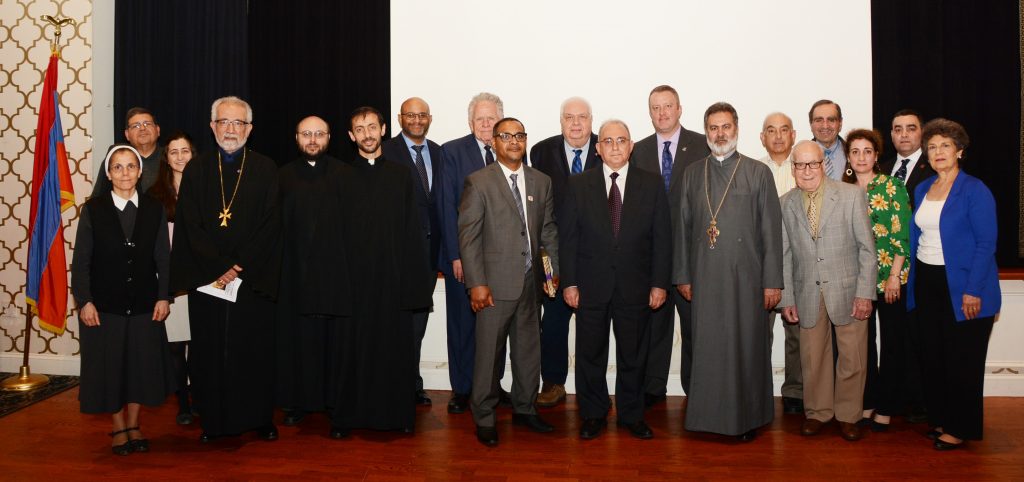

The community-wide gathering was organized by Steven Keytanjian and fellow leaders of the Armenian Inter-Communal Committee of Philadelphia, which consists of representatives from the five area churches, their clergy, and the Armenian Sisters Academy. The presentation took place at St. Sahag & St. Mesrob Armenian Apostolic Church in Wynnewood, PA, and Andrew Kzirian served as Master of Ceremonies.
The ANI exhibit titled “The First Deportation: The German Railway, the American Hospital, and the Armenian Genocide” was dedicated to Steven Keytanjian’s grandfather, Dr. Charles Mahjoubian. The First Deportation exhibit concludes with testimony from Dr. Mahjoubian, a native of Konya who resettled in Philadelphia. As a survivor, he committed himself to testifying to the events he witnessed in his hometown.
“Thank you to the entire Armenian American community in Philadelphia for welcoming the Armenian National Institute’s exhibit on the YMCA, and participating in the shared history of Armenia and the United states that dates back over a century,” ANI Director Dr. Rouben Adalian stated. “It was especially encouraging and a true honor to have in attendance representatives of the YMCA, and be able to thank on this day of remembrance the deeply committed and selfless YMCA volunteers who put themselves in harm’s way and helped so many survivors of the Armenian Genocide,” he added.


Last year, Armenia YMCA welcomed the release of the special digital exhibit, and joined the Armenian Assembly of America in presenting the exhibit in Armenia and Artsakh, with the help of Vardan Hambardzumyan, who heads the YMCA in Armenia and presently serves as Executive Secretary of Europe YMCA. To date, the exhibit has been shown in Yerevan, Stepanakert, and the American corner in Gyumri, and presently is on display in Vardenis through the continuing sponsorship of the YMCA. This past Friday, YMCA leaders from Germany, Spain, Russia, Georgia, Ukraine, and Belarus attended a private opening of the exhibit in Vardenis.
Ryan Bean, Reference and Outreach Archivist at the YMCA Archives, who supported the project, remarked: “The Armenian National Institute has done a fantastic job telling this story. It is both tragic and heartbreaking on the one hand, and inspiring and humbling on the other. The timeliness of this exhibit is very appropriate, and I believe we could all learn a lesson from Elder and Arroll.”
The YMCA Archives extended congratulations to Dr. Rouben Adalian and the Armenian National Institute on the release of the digital exhibit in 2018, and added: “This exhibit both illuminates a tragic humanitarian disaster as well as highlights the capacity of the human spirit to persevere and do good in the face of a seemingly hopeless situation.”
Vardan Hambardzumyan, from Armenia YMCA and Europe YMCA, wrote that he was “absolutely grateful to ANI for disclosing so eloquently the story of the YMCA in the Republic of Armenia back in 1918.”
Earlier in April, Dr. Adalian presented on the YMCA at St. John the Baptist Armenian Orthodox Church in Milwaukee, WI. “It was a particular pleasure to share the exhibit in Milwaukee, where in attendance was Mr. Ara Churchian who identified himself as a former student of John Elder when decades ago he attended the American Presbyterian Missionary School – now called Community School – in Tehran, Iran. The audience was quite excited to learn that one of their parishioners knew John Elder in person. I thank Mr. Churchian for his participation and especially the St. John the Baptist Armenian Church Parish Council and its Chairman Lyle Dadian for organizing the event, and Father Nareg Keutelian who presided,” Dr. Adalian said.
The YMCA digital exhibit is one of seven exhibits developed by ANI based on American documentation of the Armenian Genocide. Earlier this month, ANI released “The United States Military in the First Republic of Armenia 1919-1920,” a groundbreaking exhibit that documents the extent of U.S. humanitarian intervention during the difficult years in the life of the newly-formed Armenian state in the aftermath of the Armenian Genocide. Based upon the photographic collection of an American medical officer, Dr. Walter P. Davenport, the exhibit reveals the depth and breadth of measures taken by U.S. military personnel to stabilize the humanitarian crisis in Armenia, and especially the caretaking of the most vulnerable part of the population through hospitals, orphanages, food distribution points, and other facilities.
All of the digital exhibits posted on the ANI website are freely downloadable on www.armenian-genocide.org, and are provided to the public in high resolution to be readily printable anytime and anywhere from standard-size to poster-size.
Founded in 1997, the Armenian National Institute (ANI) is a 501(c)(3) educational charity based in Washington, D.C., and is dedicated to the study, research, and affirmation of the Armenian Genocide.

